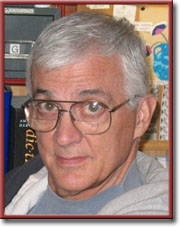Be Not Conformed to This World: Eccentricity

Skip the B.S.
By Skip Eisiminger

“There’s the son of Bertrand Russell who crocheted himself a pair of pants from a giant ball of string he’d saved. There’s Flannery O’Connor, at age six, teaching a chicken to walk backwards. There’s crossword editor Will Shortz creating and winning the first degree in enigmatology. And finally, there’s that one young woman headed to the beach with a surfboard on her roof as thousands jam the Interstates fleeing Hurricane Katrina. As Marianne Moore in her tricorn said, ‘It’s an honor to witness so much confusion.’”—By Skip Eisiminger
“Some won’t give their children a rocking horse/because the group spirit is not enforced./Some children eat bugs but could not care less/what the group thinks of their weevily excess.”—The Wordspinner
 CLEMSON South Carolina—(Weekly Hubris)—4/7/2014—Rubbing his hands with delight, the French entomologist Henri Fabre watched in his greenhouse as a hundred or more moth caterpillars climbed in single file to the rim of a clay pot. Guided by the overlapping filaments each individual laid down, these Pine Processionaries completed the yard-and-a-half circuit in about 15 minutes. Each of these creatures has ten eyes and multiple olfactory glands, but they are almost entirely dependent on their sense of touch.
CLEMSON South Carolina—(Weekly Hubris)—4/7/2014—Rubbing his hands with delight, the French entomologist Henri Fabre watched in his greenhouse as a hundred or more moth caterpillars climbed in single file to the rim of a clay pot. Guided by the overlapping filaments each individual laid down, these Pine Processionaries completed the yard-and-a-half circuit in about 15 minutes. Each of these creatures has ten eyes and multiple olfactory glands, but they are almost entirely dependent on their sense of touch.
Before any of these future aviators realized they were about to stumble onto the rail they’d laid down just minutes before, Fabre brushed away all traces of that which had led them to the rim of this pot. Around they lumbered for a week, sleeping at random intervals on the shoulder of their silken highway, which grew thicker with each passing.
One sleep walker on the seventh day made a delirious break for the floor, but it and the handful that followed soon returned to their fellows circling above. On the eighth day, however, another starving forager stumbled off the track and headed for home. This time, there was no turning back. By nightfall, all were in their pine-tree nest a few pots over, their bellies full, but still visibly slimmer than when they’d marched off.
Aesop might have moralized, “The conformist plows a rut, not a furrow,” but I know that Nature has given this obtuse organism a means for finding its way back to the nest, for therein lies warmth outside of the greenhouse. Ruts have a bad reputation in wisdom literature but, when we are sidetracked, ruts and rails lead us back to our nests, while furrows lead to more furrows. Nevertheless, it is the caterpillar that breaks ranks that I celebrate here.
But first, a little history. Realize that “eccentric” wasn’t an English word until after William Shakespeare died; “originality” first appeared as a pejorative in Samuel Johnson’s day, and “individuality” made its debut 20 years after John Keats’ death.
Though we may not have had a word for her, in the beginning was Eve, our unpredictable Ur-mother, who predictably decided that banning one fruit tree in an otherwise unrestricted orchard was unreasonable. Who else was going to eat this fruit? And like that unorthodox caterpillar, Eve made up her mind before she could reason.
Skipping forward a few millennia, there’s Isaac Newton exploring optics while probing behind his eyeball with a curved needle. There’s Francisco Goya painting at all hours after affixing several candles to a stiff-brimmed hat. There’s Byron’s lover, who terminated their relationship by sending his lordship a lyrical lock snipped from her lady parts. There’s Sarah Bernhardt on the English stage with a taxidermied bat pinned to her bouffant. There’s DuPont de Nemours editing the bi-lingual Nightingale-French Dictionary before founding a chemical company. There’s the son of Bertrand Russell who crocheted himself a pair of pants from a giant ball of string he’d saved. There’s Flannery O’Connor, at age six, teaching a chicken to walk backwards. There’s crossword editor Will Shortz creating and winning the first degree in enigmatology. And finally, there’s that one young woman headed to the beach with a surfboard on her roof as thousands jam the Interstates fleeing Hurricane Katrina. As Marianne Moore in her tricorn said, “It’s an honor to witness so much confusion.”
I never had the honor of witnessing any of the eccentrics above, but I have observed a few lesser lights whose orbits wobble, for unlike those nose-to-hind-quarters processionaries, human eccentrics are recognized by the oxbows they carve in space.
A German friend of ours had long known of her sister’s fondness for Tiffany glass. When the sister turned 60, our friend purchased a colorful lampshade, packed it securely, and declared it was a carry-on parcel at the airport. But because of the gift’s size, the ticket clerk said she’d have to check it through to Frankfurt, whereupon our friend excused herself and retired to the ladies’ room. Here, she unpacked her shade, placed it on her head, disposed of the box, and went unabashedly to obtain her boarding pass from a different clerk. Once on the plane, she wrapped her shade in a blanket and braced it with pillows in an overhead compartment. In Frankfurt, she positioned it once more on her head and strode to a connecting train where many stared, but no one questioned her chutzpa.
My own “freak flag” is more of a flannel pennant, but I wouldn’t be writing for Weekly Hubris if I were a buttoned-down, white-bread writer.
Since high school, when I chose track and field with 20 other prima donnas who refused to be herded by the revenue-sport coaches, I have meandered to a different harpist. Once the school’s basketball coach came to my trigonometry class, where he pulled rank on our young teacher and led me to the hall. He said that any young man such as myself who was 6’ 4” and reasonably coordinated should be playing basketball in the winter, baseball in the spring, and football in the fall. That’s when I decided to jump in the mound of wet sawdust (called the high-jump pit) behind the football stadium.
That rash but independent decision was followed by dropping out of college to join the Army Security Agency, marrying a German woman some in my family disapproved of, fathering a child in my freshman year the second time around, dropping Business for an English major, and writing rhyming verses on the side. According to one of my department heads, I was a generalist in a world of specialists, so I should not expect to rise fast nor far.
Nevertheless, 50 happy years later, I am still married to the same woman and still turning out rhymes. (There are four of them in the epigraph.) Moreover, 42 years after entering the classroom, I was awarded the title “Emeritus Professor of English and Humanities.” At my retirement party, a colleague with an ear for Southern dialect claimed that I had contracted “em-er-EYE-tis” which, he assured me, is a fatal but universal condition.
I have no quarrel with my new title, regardless of how it’s pronounced. I admire the moral courage it took for the state to hire an unpublished poet who rode a bike to school and played a lot of softball. Yet for most of those 42 years, that much-criticized state would have vouched for me if someone did not like what I said in the classroom.
Like many who meander to that un-tuned harpist, I’m torn between doing something new and following tradition, so I do lots of both which keeps me off the “psycho path.” If I bowl any more, I bowl with family or friends; never alone or in a league. Sometimes, I’m the round peg in the square hole; other times, I’m the square peg in the round hole. Neither is a great fit, but I enjoy rattling the dominant paradigm, whatever its shape might be.

Since 2012, there’s been a towering bust of Nelson Mandela in South Africa near the village of Howick. Sculpted by Marco Cianfanelli from stainless-steel shafts about 30 feet tall, the bust from most angles is a vertical abstraction set against the plains and mountains behind it. Though the face is well known, Mandela is unrecognizable until the viewer locates the precise point of view which snaps the face into focus. Somehow, these steel poles demand that proper attention be paid. Until that spot is located, one sees nothing but 50 rough bars set in concrete, much like the Robben Island “prism” Mandela saw his home through for 27 years.
Like the Martin Luther King Memorial in Washington, Cianfanelli’s sculpture is the state’s way of saying to dissidents and minorities, “We’re sorry. We’ll try to do better next time.” The state has many responsibilities, but none greater than learning from the past.

Note: Skip Eisiminger’s latest book, a collection of his Weekly Hubris (among many other) essays, Letters to the Grandchildren, has just been released by Clemson University Digital Press. To order copies, contact: Center for Electronic and Digital Publishing, Strode Tower, Box 340522, Clemson SC 29634-0522 (also, an order form is available online at http://www.clemson.edu/cedp/cudp).
3 Comments
Elizabeth Boleman-Herring
Skip, Ur-Essayist, congratulations on the new book!!! I’m going to UNDERLINE and HIGHLIGHT my copy . . . and there will be a test!
Skip
Game on–do I get to reciprocate using The Visitors’ Book?
Elizabeth Boleman-Herring
Yep, sure do, Skip! :-)